Smartphone, Computer And Tablet Viewing Shows Surprising Coexistence With Traditional TV

Across the board, all demographics are consuming more digital content on computers and smartphones than ever, but digital content is not yet replacing TV but rather adding to it. As audiences’ media habits become more diverse and complicated, it’s not so much that people are turning their televisions off, as much as they are turning everything else on.
Nielsen’s quarterly Total Audience Report (formerly the Cross-Platform report), which details content consumption patterns and audience trends across all platforms and demographics, revealed, to no one's surprise, increased saturation of digital devices. Smartphone saturation increased 15 percent over the last year to reach 75 percent of homes, while tablets jumped 59 percent over the last year to reach 46 percent of homes.
New to the digital game are older demographics. According to the report, adults over 55 – the group that still consumes the most traditional television of any demographic – experienced a 55 percent increase in digital video consumption – content accessed via computer, tablet or smartphone – in hours per day over the last year.
Additionally, adults ages 18-48 saw a 53 percent increase in digital video consumption, while adults ages 25-54 saw a whopping 62 percent increase.
But increased consumption of digital content is not eating away at traditional TV at the rate many have projected. Digital consumption by the over-55 demo is almost entirely additive. The 55 percent increase in digital video consumption was coupled with no change in TV screen viewing.
In fact, even in adults 18-49, the demo most coveted and catered to by advertisers, a 53 percent increase in digital video consumption was met with only a 3 percent decrease in TV screen viewing, a proportion that suggests there may not be a swift takeover of television by digital in the near future.
In the introduction to the Total Audience Report, Nielsen's SVP of insights, Dounia Turrill, says, “The growing penetration of new devices and the popularity of subscription-based streaming services, time-shifted, and over-the-top viewing – as well as cord-cutting and cord-shaving – are fundamentally changing the TV industry.”
While this is undeniable, the rate and nature of that change is still up for debate. The data in the report suggest that a coexistence, at least temporary, may be achieved between traditional TV and digital content. The largely additive nature of digital consumption so far suggests that consumers are perhaps using digital content either simultaneously or to fill in content gaps, while commuting or on the computer and phone at work, than to replace their televisions.
Television is still king, as adults 18 and over spend an average of nearly 33 hours a week in front of their TV sets, according to Nielsen, the most time of any medium. Using an app or the mobile Web on a smartphone is a distant second at just under 7.5 hours per week.
Digital has made itself a major player in the consumer content experience, but it is still part of a very diverse media landscape in which television, despite a slow decline, remains a major player.
Do you watch more TV or digital content? Tweet your thoughts to @Ja9GarofaloTV.
© Copyright IBTimes 2025. All rights reserved.






















